A Newly Discovered Nova in Hercules

On June 12th a Japanese amateur astronomer, Seiji Ueda, discovered a nova in the constellation Hercules. The nova peaked at an estimated apparent magnitude 5.5, almost naked-eye visible to someone living in a dark location. At this magnitude it was easily visible to anyone with a pair of binoculars or a small telescope, even from midtown Manhattan! Unfortunately, we had inclement weather, so the first day I was able to image the nova was on June 16th, and by then it had rapidly faded to an estimated magnitude of around 8.5. As I write this on June 23rd, it has further faded to an estimated apparent magnitude 12. Unfortunately, this was not a super nova, which occurs when a star destroys itself in a cataclysmic explosion. Instead, this event was what is sometimes called a Classical Nova or a Cataclysmic Variable Star. These types of stellar explosions occur in star systems that comprise of a white dwarf star that is in orbit with a larger main sequence companion star. White dwarf stars can create both classical novae and Type 1A Super Novae. A type 1A super nova explosion occurs when a white dwarf star destroys itself due to a runaway thermonuclear reaction. However, in a classical nova such as this one, the erupting nova is the result of the white dwarf star’s surface bursting into spontaneous fusion and suddenly producing a tremendous amount of radiation and energy. The intense gravity from the white dwarf star pulls hydrogen from its companion star as it swings close by. Then, as the excess hydrogen accretes on the surface of the white dwarf, it will generate a tremendous amount of pressure in the white dwarf star’s outer layers. Eventually, the pressure and heat hit 10 million degrees kelvin, producing nuclear fusion in this outer layer of the white dwarf star and creating this spectacular eruption. The amount of energy produced in this type of event can be up to 1037 joules, and it can brighten the star by anywhere from 6 to 19 magnitudes. In this case, we believe the brightening was about 14 magnitudes, given the increase in brightness from about magnitude 20 prior. Using this, we can work out a distance of something like 18-20 thousand light years from Earth. This nova was located here in our very own Milky Way Galaxy, roughly in the direction of the galactic bulge:
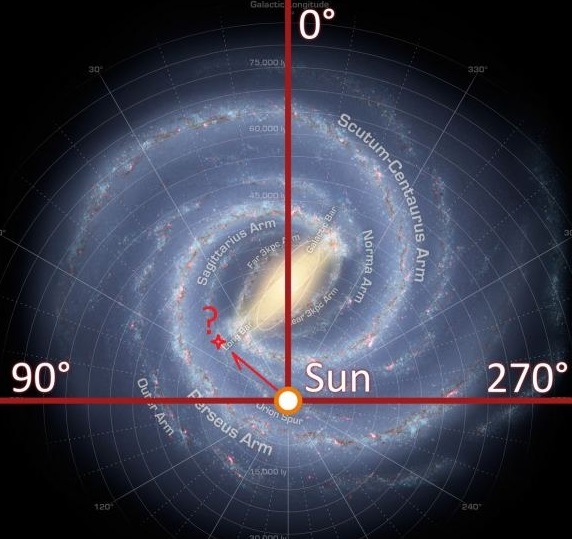
I was able to image the nova on the evening of June 16th from my upstate Connecticut country home, and you can see in the astrometry.net solve image below, the approximate location of the nova which is at coordinates RA 18h57m32s and DEC +16o51’46”.
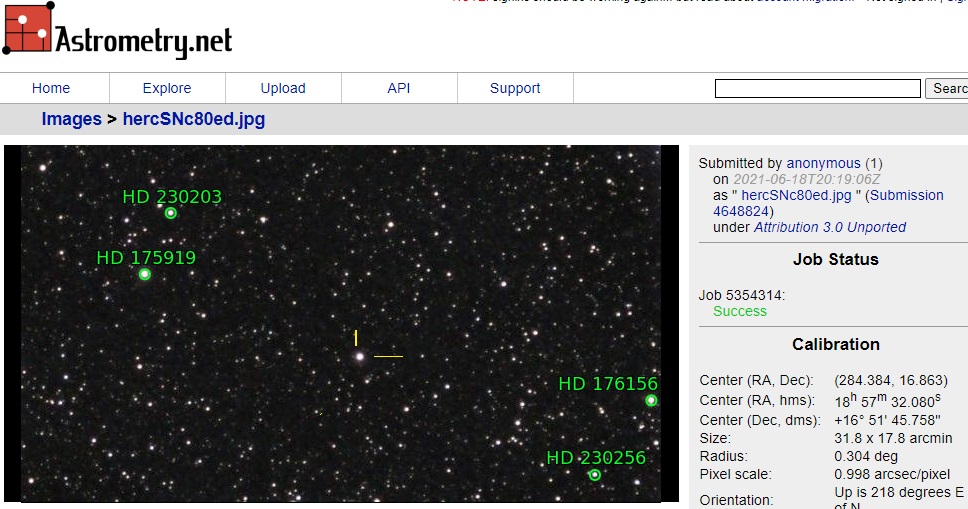
I imaged the nova both with my Celestron 11-inch telescope at F10 and with my guide scope, a Celestron 80mm ED refractor, and in both cases we can see that there is no associated host galaxy. That was a clue right away that this nova was likely not a super nova. The image from my guide scope was taken with a ZWO 462c color camera and the field of view is approximately 32’x18’:

I also imaged the nova with the much larger 11” scope using a ZWO 294mc color camera and at 2800mm of focal length:

The next step was to obtain a spectrum of the nova, which you can see in Image 5 below:

I have a Star Analyzer 200, which is a small 1.25” filter that goes in a filter-wheel that I have attached to the C80 refractor telescope. The other spectrum lines represent different stars in the same field of view. But we can strip down and isolate the spectrum of the nova by isolating it and then running it through a spectrum analyzing program. When we first isolate the spectrum and then run it through EasySpec, which is a free spectrum analysis program, we can immediately spot the emission lines:

Notice the very bright Hydrogen-alpha at 6,523 angstroms. It is very bright and evident, both in the extracted spectrum (see below the graph) and in the peak of the intensity in the annotated graph. The source of this bright emission line, and indeed the reason for the red color of the star, is that we are actually seeing and measuring the unburnt hydrogen from the surface of the star as it expands outward from the star. Other amateurs who were able to capture the nova’s spectrum on the first day of the eruption were able to measure the velocity of this expanding shockwave at nearly 3,500 km/s. What is amazing to consider is that this massive hydrogen explosion on the surface of this star, nearly 20,000 light years away, is clearly captured by this modest backyard telescope!
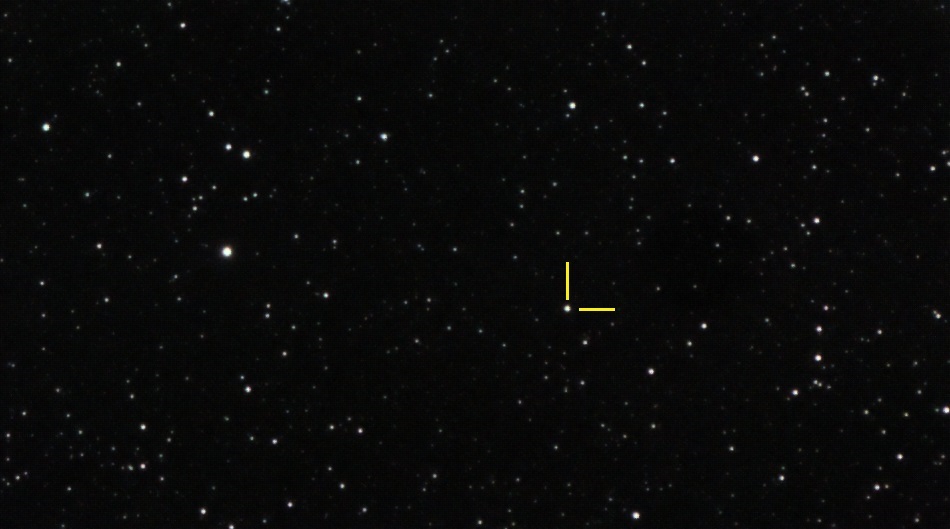
When I managed to capture a follow-up image of the nova on the evening of June 23rd, it had faded significantly over the intervening seven days. As you can see in the following picture from my C80 guide scope it is no longer as bright as in Image 3 above. In the picture below, the top image is a crop from June 23rd, while the bottom image is from June 16th, and the fading in the star is evident. The two stars on the lower right are both about apparent magnitude 12, so they serve as a good comparison for determining the current magnitude of the nova:
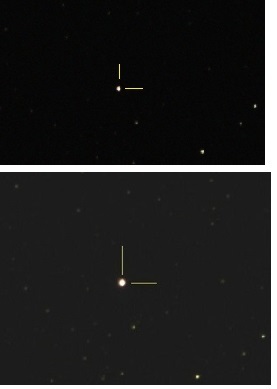
The spectrum analysis gives us a very clear indication of just how much less energy we are capturing just a week later. If you look at the spectrum from June 16th (Image 6 prior), you can see on the vertical axis that the H-Alpha emission line peaks at over 6,000 while the H-Beta emission peaks at just over 3,500. Now look at the spectrum analysis from June 23rd, just seven days later:
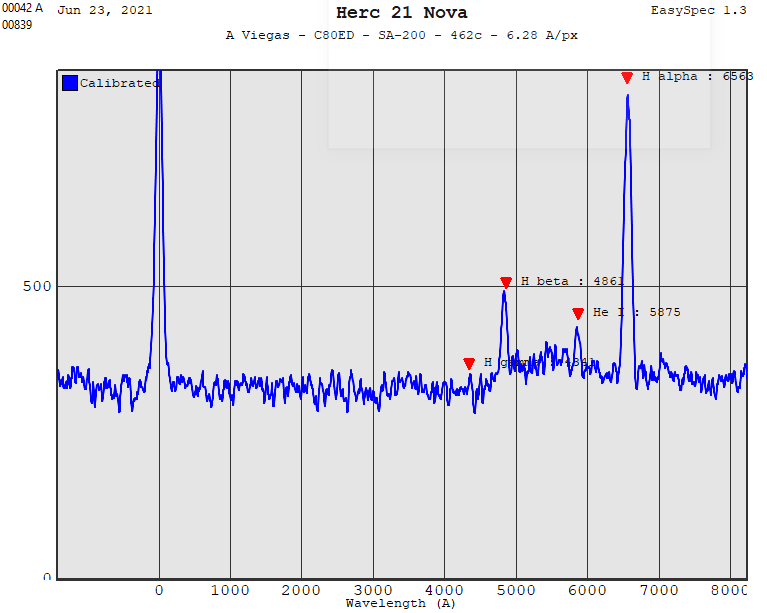
We can still see the telltale H-Alpha and H-Beta emission lines, but now note the scale on the vertical axis. The H-Alpha has declined to about 900 and the H-Beta is just under 500 units of flux. So we can directly measure about an 86% dimming of the white dwarf star as the incredible energy released in the explosion on its surface dissipates into space.
Because the white dwarf and its companion star remain intact following the explosion, we expect to see a repeat over the course of years or centuries— so keep an eye out for this nova to blaze again sometime in the future.




